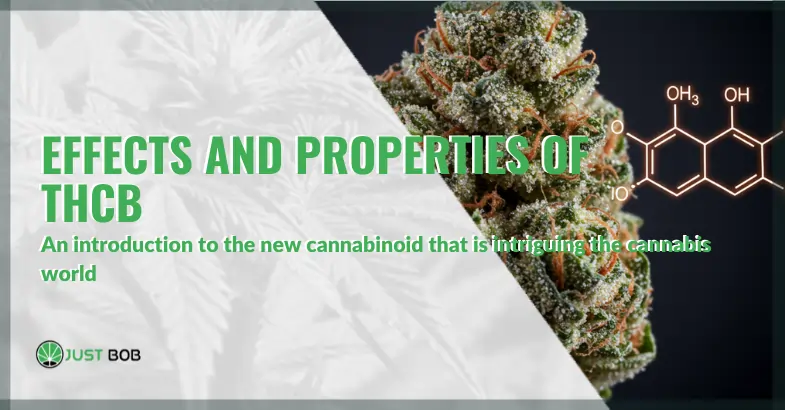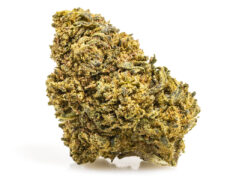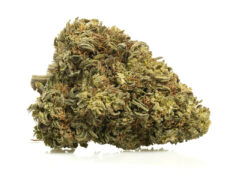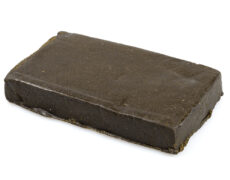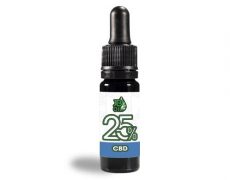Published on: 10/07/2025
An introduction to the new cannabinoid that is intriguing the cannabis world
The vast and fascinating universe of cannabis never ceases to amaze us, constantly offering new discoveries.
Until a few years ago, THC and CBD were the undisputed stars of the show, but today the landscape has been enriched by numerous minor cannabinoids that are capturing the attention of researchers and enthusiasts alike. Among these, one of the most talked about is undoubtedly tetrahydrocannabutrol, better known as THCB.
This compound, although identified decades ago, has only recently been isolated and studied in depth. Its uniqueness lies in a chemical structure very similar to that of the more famous THC, but with a crucial difference that could alter its interaction with our body and, consequently, its effects.
This article aims to be a comprehensive guide to exploring every aspect of THCB. We will analyse its history, its molecular structure and what makes it unique.
We will delve into the current knowledge about its potential effects, comparing them with those of THC and other emerging cannabinoids, and we will try to clarify its legal status, which is always a complex and evolving issue.
The aim is to provide a clear and detailed picture, based on the scientific information available today, to fully understand what THCB is and why there is so much talk about it.
If you are a connoisseur of this world, including that of CBD cannabis, curious about the latest industry news, or simply looking for accurate and up-to-date information, you are in the right place.
Read on to find out everything you need to know about the effects and properties of THCB.


The discovery of THCB: a “new” arrival in the cannabis family
Contrary to what you might think, THCB is not a recent discovery. Its first traces in scientific literature date back to 1942. However, for decades, this cannabinoid remained in the shadows, a mere footnote in complex treatises on the chemistry of the cannabis plant.
The real breakthrough came in 2019, when a team of Italian researchers, analysing hemp samples, rediscovered and successfully isolated tetrahydrocannabutrol. This event marked the beginning of a new chapter in cannabinoid research, shifting the spotlight to molecules that had previously been considered minor or of little interest.
The reason for this rediscovery lies in advances in analytical technologies, which now make it possible to identify compounds present in infinitesimal traces in the plant.
THCB is a minor cannabinoid, which means that its natural concentration in cannabis is extremely low. This makes its direct extraction from the plant a complex process.
For this reason, most of the THCB available on the market today is produced in laboratories through semi-synthetic processes, a method that starts with more abundant natural cannabinoids, such as CBD, and chemically modifies them to obtain the desired molecule.
This rediscovery has paved the way for new scientific investigations, stimulating curiosity about the unique properties of this compound and its potential.
Read also: Cannabinoids: short and long-term effects of THC, CBD, CBG and other active substances
What is THCB made of? The butyl alkyl chain that makes the difference
At first glance, the THCB molecule and the THC molecule might look like twins.
The distinctive feature of THCB, which makes it unique, lies in its side alkyl chain, a kind of “tail” attached to the main body of the molecule. While common THC has a chain composed of five carbon atoms (called pentyl), THCB has a butyl chain, i.e. with only four carbon atoms.
This variation, which may seem insignificant, is actually the focus of all the scientific interest surrounding this cannabinoid.
It is precisely the shape of this “tail” that determines how a molecule binds to the receptors in our endocannabinoid system, a complex network of cellular signals that helps regulate functions such as mood, appetite and sleep.
In particular, this structural difference influences the binding to CB1 receptors, a kind of biological “antennae” concentrated mainly in the central nervous system, which are responsible for the psychotropic effects of cannabinoids.
The theory suggests that the shorter chain of THCB could influence its binding affinity, making it different from that of THC. Some studies indicate that the binding of THCB to CB1 receptors may be stronger, which could translate into a unique effect profile, with a potency and duration that differ from those of its more famous cousin.
It is this subtle but significant difference that makes THCB an intriguing candidate for future research.
THCB vs THC: what are the main differences?
The question that naturally arises is: in concrete terms, what is the difference between THCB and THC?
We have already seen some of the differences in the previous paragraph: the main distinction, linked to the different molecular “tail”, affects how they interact with our body’s receptors. Early research suggests that THCB may have a different affinity for CB1 receptors. In theory, this could mean greater psychoactive potency or a qualitatively different experience.
However, it is important to emphasise that research is in its infancy and user reports often suggest that the effects of THCB are intense and rapid, but perhaps shorter-lasting than THC.
In terms of perceived effects, users, where consumption of this substance is legal, report sensations very similar to those of THC, such as euphoria, relaxation and altered perception. Some preliminary studies in animal models have also highlighted potential anti-inflammatory and analgesic properties for THCB, suggesting that it may be more effective than THC in these specific areas.
However, further research is needed to precisely define the profile of this intriguing emerging cannabinoid.
THCB versus other cannabinoids: THCP, HHC and CBD compared
The cannabinoid landscape has become crowded with acronyms, and it can be difficult to navigate. Let’s see how THCB compares to other known compounds.
The most interesting difference is with its “brother” THCP, discovered by the same team. While THCB has a chain of 4 carbon atoms, THCP has 7. It is theorised that this longer chain allows THCP to bind to CB1 receptors with up to 30 times the strength of THC, making it potentially much more powerful.
THCB thus occupies an intermediate position, with a potency profile yet to be defined but probably closer to that of classic THC.
Another useful comparison is with HHC (hexahydrocannabinol).
Unlike THCB, which is a natural homologue of THC, HHC is a hydrogenated cannabinoid, i.e. created by adding hydrogen atoms to the THC molecule. This chemical process increases its stability but also alters its effects, which are often described as milder and more relaxing than THC.
Finally, it is essential not to confuse THCB with CBD (cannabidiol). While THCB is psychoactive, CBD is not at all, as it interacts very differently with the endocannabinoid system, without binding significantly to CB1 receptors. This distinction is crucial and highlights how each cannabinoid, even if derived from the same plant, has a unique chemical identity and effects.
The potential effects of THCB: what preliminary research says
When discussing the effects of THCB, it is essential to proceed with caution. Scientific research is still in its infancy, and most information comes from preliminary studies, often conducted in vitro (i.e., in a test tube, outside a living organism) or on animal models.
That said, early results are promising. Because THCB binds to CB1 receptors in the central nervous system, just like THC, it is expected to have similar psychoactive effects. Users describe an experience that can include euphoria, relaxation, increased energy and a general feeling of well-being, with altered sensory perception and perception of time.
Some studies suggest that its psychoactive potency may be significant, although the debate over its superiority over THC is still open.
Beyond this, research is focusing on potential therapeutic applications. A 2020 study indicated that THCB shows promising anticonvulsant properties in mice, i.e. the ability to counteract or reduce seizures.
In the same year, other research suggested that THCB has significant anti-inflammatory and analgesic properties.
It is crucial to reiterate that these are preliminary findings and that clinical studies in humans are needed to confirm the safety and efficacy of THCB, but the premises for further investigation are certainly very interesting and noteworthy.
Is THCB legal? An overview of the legal situation in Europe
The legality of new cannabinoids such as THCB is one of the most complex and fluid issues of the moment, creating a significant “grey area” in much of Europe.
The problem stems from the fact that many national and EU laws were written to specifically regulate Delta-9-THC, leaving these new semi-synthetic molecules uncovered. The legality of THCB therefore depends on the interpretation of existing laws on drugs, psychotropic substances and, in some cases, food.
In many countries, if a substance is not explicitly prohibited, it is not automatically legal for consumption, especially if it is synthetically produced and has psychoactive effects.
Many EU member states are beginning to address the issue, often banning these cannabinoids one by one as they gain popularity, as has been the case with HHC. In addition, for any product intended for consumption, the European Novel Food Regulation comes into play, requiring lengthy and costly authorisation for any “novel food” not consumed to a significant degree before 1997.
Given this uncertainty, it is essential for enthusiasts in the industry to be aware that high-quality products, such as those based on CBD offered by JustBob, are sold for specific purposes such as collection, research or room fragrancing, and not for consumption, in full compliance with the regulatory framework.
It is always crucial to check local laws before purchasing any product, as the situation can change quickly.
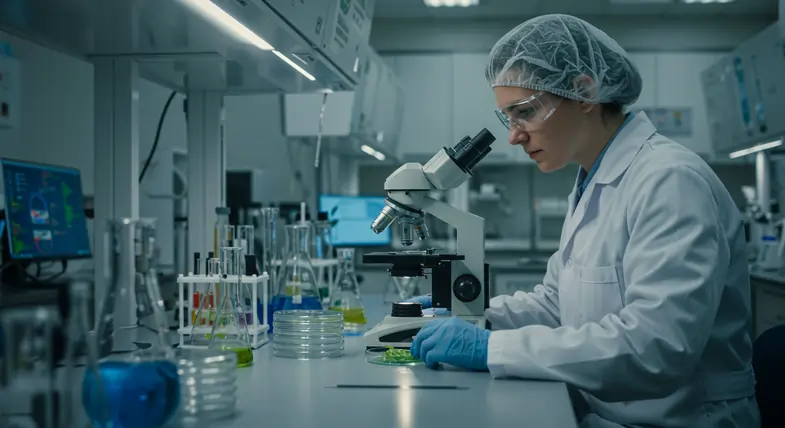

The future of THCB and the role of scientific research
The journey of THCB has only just begun, but the stage is set for a future full of developments. The main challenge will be to overcome the scarcity of clinical studies in humans.
It will be essential to initiate in-depth research to understand not only the efficacy of THCB, but also its long-term safety profile and possible interactions with other drugs.
Only then will it be possible to move from promising initial hypotheses to solid scientific evidence.
Another crucial aspect will be the development of safe and standardised production methods. Since semi-synthesis is the main route for obtaining THCB, it is imperative that manufacturers guarantee the purity of their products through independent laboratory analysis.
In this scenario, the importance of the legal hemp industry and its derivatives also emerges. Products such as CBD buds, although not intended for consumption, keep the spotlight on the plant and stimulate informed debate, contributing to greater general knowledge. The future of THCB will depend heavily on the synergy between rigorous scientific research, clear regulation and a responsible industry capable of offering safe and transparent products.
There is still a long way to go, but the interest surrounding this cannabinoid is the driving force that will push science to find the answers everyone is looking for.
Read also: THC and CBD: what are they? Here are all the differences
What we have learned about THCB
At the end of this in-depth analysis, we can take stock of tetrahydrocannabutol. We have discovered that THCB is a recently “rediscovered” cannabinoid that differs from THC by a small but significant difference in its chemical structure.
This unique feature could give it a different affinity for our body’s receptors, opening up a potentially new profile of effects. Preliminary research, although limited, has offered promising insights, suggesting analgesic, anti-inflammatory and anticonvulsant properties. However, the need for caution has emerged strongly.
The psychoactive effects of THCB, believed to be similar to those of THC, and its predominantly semi-synthetic nature place it in a complex and uncertain legal grey area in many countries.
For enthusiasts approaching this world, perhaps through cannabis light products such as CBD oil, intended for aromatherapy or room fragrancing, awareness and information are the most valuable allies.
THCB represents a fascinating new frontier in the ever-expanding field of cannabinoid science. Its future will depend on the scientific community’s ability to provide clear answers about its safety and efficacy and on the creation of a clear and consistent regulatory framework.
There is still a long way to go, but interest is high, and this is always the first step towards a deeper understanding.
Effects of THCB: takeaways
- THCB is a minor cannabinoid with a structure similar to THC, but with a shorter (butyl) alkyl chain: this structural difference is what makes THCB interesting for scientific research. It influences how the molecule interacts with the CB1 receptors of the endocannabinoid system, with potentially different psychoactive effects, which may be more intense but shorter-lasting than THC.
- Research is early but promising, with preliminary evidence of analgesic, anti-inflammatory and anticonvulsant properties: animal model studies and in vitro tests suggest that THCB may offer superior therapeutic benefits in some areas compared to THC. However, clinical studies in humans are still lacking to confirm long-term efficacy and safety.
- The regulatory landscape is uncertain and evolving, especially in Europe: as a semi-synthetic molecule with psychoactive effects, THCB falls into a legislative grey area. Its legality depends on the interpretation of national laws and European regulations on “novel foods”, making it essential to check local regulations before purchasing or using it.
Effects of THCB: FAQ
What is THCB and how does it differ from THC?
THCB is a minor cannabinoid found in cannabis, similar to THC but with a slightly different chemical structure: it has a butyl alkyl chain, while THC has a pentyl chain. This small difference could affect how THCB binds to receptors in the endocannabinoid system, leading to potentially more intense and rapid effects, albeit with a shorter duration.
What are the main effects of THCB according to early research?
Preliminary research suggests that THCB has psychoactive effects similar to THC, such as euphoria, relaxation and altered perception. In addition, some animal studies indicate potential anti-inflammatory, analgesic and anticonvulsant properties. However, further clinical studies are needed to confirm its safety and efficacy in humans.
Is THCB legal in Europe?
The legality of THCB in Europe is unclear and varies from country to country. Many regulations refer specifically to Delta-9-THC and do not explicitly include THCB, creating a legal grey area. In some states, cannabinoids such as THCB are being regulated as they become more popular. It is therefore essential to consult local regulations before purchasing or using products containing THCB.

